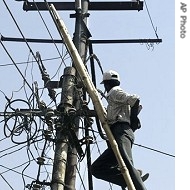-
(单词翻译:双击或拖选)
By Anjana Pasricha
New Delhi
06 June 2008
India is coping with huge energy shortfalls as a growing economy raises demand for power. But as Anjana Pasricha reports from New Delhi, the government has pledged to cover the gap in five years.
 |
| Electrician repairs power cable on electricity pole in Allahabad, Uttar Pradesh, 12 May 2008 |
Temperatures frequently soar above 40 degrees Celsius1 across the vast plains of India as the summer heat peaks. But for most people, like 54-year-old Renuka Taimni in New Delhi, the sweltering heat is worsened by the frequent power outages.
"The frig did not work, the AC does not work, brings life to a standstill, you can't do anything, you just sit waiting for the power to come back," said Taimni.
The situation is equally bad across other big cities such as Kolkata or Mumbai.
And it is much worse in smaller towns and rural areas, where power blackouts can last for more than 12 hours a day. Last month, violent protests erupted across India's most populous2 state, Uttar Pradesh, as long outages left people without fans and even drinking water.
Power blackouts have been a regular feature of life in India for many years. But a five-year-long economic boom has intensified3 these shortages as expanding industries guzzle4 more power, and a growing middle class can afford more air conditioners, refrigerators and washing machines.
An energy advisor5 to the Confederation of Indian Industry, V. Raghuraman, says the current power capacity generation is about 14 percent short of demand.
"For the last 15-16 years we have not been able to add capacities required. The power-demand supply gap has been actually increasing year after year," said Raghuraman.
The government has promised to change that, and provide power to all by 2012.
Industry experts like Raghuraman say the situation will improve in the coming years because massive investments are in the pipeline6.
"The investments are more than $200 billion say in the next five years … we believe a good amount of capacity will come in the next five to six years," said Raghuraman.
The power plants being built by the government are expected to add 70,000 megawatts of power generation. They include thermal7 and hydroelectric plants.
The private sector8 is also making large investments in power projects.
However, skeptics fear that many of these projects will face delays, and the gap between demand and supply will continue to grow in the coming years.
But optimists9 hope the power sector might replicate10 the success of the telecommunication11 industry. A decade ago, it could take years to obtain a phone line, but now the privatized industry is one of the fastest-growing in the world.
 收听单词发音
收听单词发音
1
Celsius

|
|
| adj.摄氏温度计的,摄氏的 | |
参考例句: |
|
|
|
2
populous

|
|
| adj.人口稠密的,人口众多的 | |
参考例句: |
|
|
|
3
intensified

|
|
| v.(使)增强, (使)加剧( intensify的过去式和过去分词 ) | |
参考例句: |
|
|
|
4
guzzle

|
|
| v.狂饮,暴食 | |
参考例句: |
|
|
|
5
advisor

|
|
| n.顾问,指导老师,劝告者 | |
参考例句: |
|
|
|
6
pipeline

|
|
| n.管道,管线 | |
参考例句: |
|
|
|
7
thermal

|
|
| adj.热的,由热造成的;保暖的 | |
参考例句: |
|
|
|
8
sector

|
|
| n.部门,部分;防御地段,防区;扇形 | |
参考例句: |
|
|
|
9
optimists

|
|
| n.乐观主义者( optimist的名词复数 ) | |
参考例句: |
|
|
|
10
replicate

|
|
| v.折叠,复制,模写;n.同样的样品;adj.转折的 | |
参考例句: |
|
|
|
11
telecommunication

|
|
| n.电信,远距离通信 | |
参考例句: |
|
|
|















